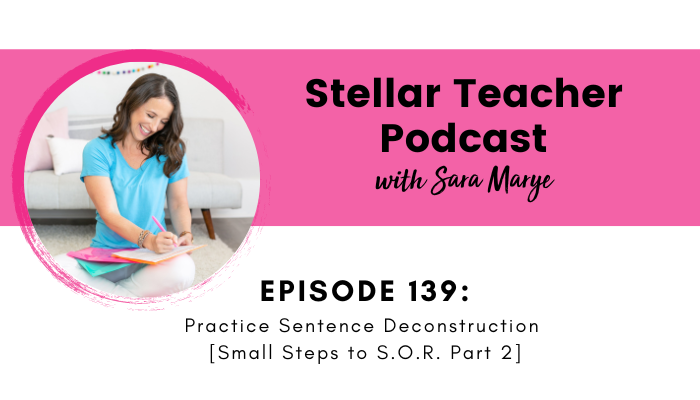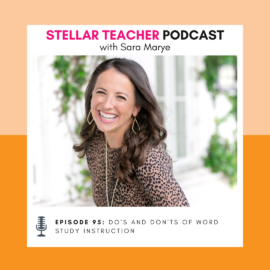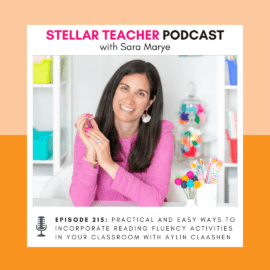
Click play below to hear ways to practice sentence deconstruction:
Aligning your instruction to the science of reading can be easier than you think. With these small steps I’m sharing with you each week, you’ll have strategies and activities to use when you return to school in the fall. This week’s step is usually associated from a writing standpoint, but is so important from a reading standpoint, which is practicing sentence deconstruction.
First, I help you understand how sentence structure aligns with the science of reading, particularly as it pertains to language comprehension. Knowing that information helps teachers understand how to effectively implement sentence deconstruction in instruction and small group lessons.
I provide a specific example of what it looks like with your students and how this simple activity of sentence deconstruction can be so powerful towards their reading comprehension. Stay tuned next week for another small step to S.O.R.
In this episode on ways to practice sentence deconstruction, I share:
- How sentence deconstruction aligns with the science of reading
- Sentence structure is one of the most ignored or overlooked aspects of reading
- Specific example on how to use sentence deconstruction with your students
- Why syntax is a big part of language comprehension
Resources:
- Sentence Writing Routine Free Sample
- Sign up for my Private Podcast: Confident Writer Systems Series
- Check out the Stellar Literacy Collective Membership
- If you’re enjoying this podcast, please leave a review on Apple Podcasts!
Related episodes and blog posts:
- Episode 137, Build and Activate Background Knowledge [Small Steps to S.O.R. Part 1]
- Episode 136, What Does the Science of Reading Look Like in Upper Elementary?
- Episode 88, Science of Reading Q&A
- Episode 87, Breaking Down the Elements of Language Comprehension (and Practical Implementation Ideas!)
- Episode 85, What is the Science of Reading & Why is it Important?
Connect with me:
- Join my newsletter
- Shop my TPT store here
- Instagram: @thestellarteachercompany
More About Stellar Teacher Podcast:
Welcome to the Stellar Teacher Podcast! We believe teaching literacy is a skill. It takes a lot of time, practice, and effort to be good at it. This podcast will show you how to level up your literacy instruction and make a massive impact with your students, all while having a little fun!
Your host, Sara Marye, is a literacy specialist passionate about helping elementary teachers around the world pass on their love of reading to their students. She has over a decade of experience working as a classroom teacher and school administrator. Sara has made it her mission to create high quality no-fluff resources and lesson ideas that are both meaningful and engaging for young readers.
Each week, Sara and her guests will share their knowledge, tips, and tricks so that you can feel confident in your ability to transform your students into life-long readers.
Tune in on your favorite podcast platform: Apple, Google, Amazon, Spotify, Stitcher, and more! If you’re loving this podcast, please rate, review, and follow!
Podcast (stellar-teacher-podcast): Play in new window | Download
Hey there and welcome to our small steps to SOR summer series. Every Thursday, I’m going to be sharing a bonus episode that gives you one small step that you can take to align your instruction to the science of reading.
Now if this is your first time tuning in, go back and listen to episode number 137, which was the first episode in our small steps to SOR series. But if you tuned in last week, let’s go ahead and jump in to this week’s small step, which is practice sentence deconstruction during reading.
Now before I get into the details of what it looks like to practice sentence deconstruction during reading, let me explain how this aligns to the science of reading. So syntax is a fancy word for understanding the rules of sentence structure. And syntax is also an element in the language comprehension strand of Scarborough’s reading rope.
And we know that in order for students to become skilled and independent readers, that they need to have skills in both the areas of word recognition, which is their ability to automatically read words, and in the areas of language comprehension, which is their ability to understand and make meaning out of the words that we read and hear.
And if students are strong in word recognition, which includes things like phonics, sight word recognition, phonological awareness, but they lack language comprehension, then they’re going to struggle to understand and comprehend what it is that they read, because they don’t have those language comprehension skills.
At the same time, if a student has really strong language comprehension skills, but they can’t actually read or decode the words, they might do well comprehending a text that is read aloud to them, and they probably can communicate well. But if they can’t independently read the words in a text, then they are going to struggle to become skilled readers on their own.
So as teachers, especially in upper elementary, if we want our students to be skilled and independent readers, and if we want to align our instruction with the science of reading, then we need to make sure that we are prioritizing and balancing both language comprehension and word recognition. And syntax is a huge part of language comprehension.
Sentence structure, like I said, which is also the same as syntax might be one of the most interesting things that I have read or researched as I’ve learned more about science of reading. And what I’ve come to realize is that it is often something that is overlooked or ignored from a reading standpoint.
We often think about syntax from a writing perspective. We talked about sentence structure, and how to write sentences and the different types of sentences. And we talk all about that from a writing perspective and during our writing lessons, but we often forget to consider how sentence structure impacts reading comprehension.
But I think it’s important to remember that the older students get, the more complex their texts become. And a complex text usually has a variety of sentence types and structures. Students are going to be expected to read and understand compound sentences, complex sentences, even simple sentences with compound subjects or compound predicates.
And if a student doesn’t fully understand the structure of a complex sentence, they’re going to have a really hard time extracting meaning from it. I think it’s important that we remind ourselves that ultimately, comprehension begins at the sentence level. And we need to make sure that students can break apart and understand the meaning behind the complex sentences they read.
When a student reads a sentence, we want them to understand who or what the sentence is about, and what is happening in that sentence. And in a lot of cases, we need to give students support in this area. But a really simple activity that you can do to help students develop a strong understanding of syntax is to practice sentence deconstruction while you are reading.
And sentence deconstruction is when you take a sentence and you start removing words to see if you can eliminate adjectives, adverbs, prepositional phrases and extra details, but still keep the heart of the sentence so it still maintains its core meaning.
So let me give you a specific example. If you are reading the picture book, Each Kindness by Jacqueline Woodson, which is a phenomenal story, if you have not read it with your students, add it to your list. It’s great for back to school. But if you’re reading this text to your students, you are going to encounter many complex sentences.
You could pick one to deconstruct with your students. And here’s an example. So one of the sentences in the text says, “Each morning, I walk to school slowly, hoping this would be the day Maya returned, and she’d look at me and smile.”
In that sentence, ultimately, we want students to understand that Chloe, who’s the one narrating the story in first person, so when we read the word I, it’s really referring to the character Chloe, and Chloe hoped Maya would return to school. But we can eliminate words and phrases until we’re left with that core idea in the sentence.
So to start, you could point out that the sentence begins with an adverb phrase each morning, and that tells us the frequency of the event in the sentence. But this phrase isn’t as essential to the understanding of the core meaning of the sentence. So if we eliminated it, we’re left with “I walk to school slowly hoping this would be the day Maya returned and she’d look at me and smile.”
And then you could point out that the author included the adverb slowly to describe how Chloe’s walking to school. But that’s an extra detail that could also be removed and still maintain the core meaning of the sentence. So if we eliminated the word slowly, we are left with, “I walk to school, hoping this would be the day Maya returned and she’d look at me and smile.”
You can point out that the second half of the sentence has a compound predicate, Maya returned and she’d look at Chloe and smile. You can discuss with your students that the most significant of these actions is Maya returned. So if we eliminated the phrase, she’d look at me and smile, then we are left with “I walk to school hoping this would be the day Maya returned.”
Then you can even talk with your students that a more concise way to say that is “I hoped Maya returned.” So doing a sentence deconstruction with your students is going to help them understand that they can take big, complex sentences with lots of phrases and details and they can break them down to get to the core idea.
We started with “Each morning, I walk to school slowly, hoping this would be the day Maya returned and she’d look at me and smile.” And we were able to get to the main idea of that sentence, which is “I hoped Maya returned.”
And doing sentence deconstruction can be really powerful for your students because it helps them understand how sentences work, they start to realize the order in which words are combined, and the rules for adding in different types of phrases. But students also realize at the very core that each sentence has a simple idea that they can successfully uncover.
Understanding sentence structure is important for writing. But it’s just as important for reading comprehension. And there’s a quote and one of my SOR books that says, “The sentence itself is a story with a beginning, middle, and end. Something happens in a sentence. Without subjects, there are no heroes or villains. And without verbs, there is no action. Without objects, nothing is moved, changed, destroyed or created.”
And I think that’s such a good reminder that if we want our students to enjoy and understand the stories that they read, then we need to make sure they understand how to comprehend at the sentence level.
So your small step to aligning your instruction to the science of reading, is to practice sentence deconstruction with your students during your reading lessons. This is something that is quick, it’s easy, it doesn’t require a lot of prep or planning on your part. And you don’t have to be a grammar expert in order to make this an effective teaching moment with your students.
So hopefully, you’ll add this to your list of things to incorporate into your read aloud and small group lessons once you’re back to school this fall. Now, be sure to tune in next Monday for our regular podcast episode and come back next Thursday for your third small step to aligning your instruction to the science of reading.








Leave a Comment
You must be logged in to post a comment.